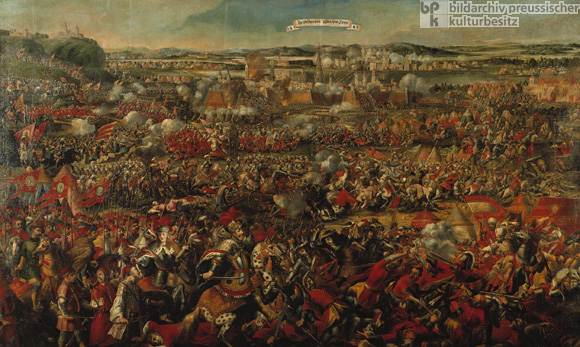













INTRODUCTION | DOCUMENTS | IMAGES | MAPS | EDITOR
|
In July 1683, roughly 150,000 Ottoman troops laid siege to Vienna, the capital of the Holy Roman Empire. Emperor Leopold I (r. 1658-1705) fled the city. Alarmed by this threat to Christian Europe, Pope Innocent XI asked Polish king Jan Sobieski (r. 1674-96) to come to Vienna’s aid. Sobieski agreed and joined Charles of Lorraine, the electors of Saxony and Bavaria, and numerous German princes in an alliance against the Turks. The combined relief army of approximately 80,000 troops consisted of roughly 27,000 Polish soldiers (among them 3,000 highly trained “Winged Hussars”); 19,000 Austrians; 10,500 Bavarians; 9,000 Saxons; and 9,500 soldiers from the southwestern German principalities. Under Sobieski’s command, imperial forces scored a decisive victory over Ottoman troops at the Battle of Kahlenberg on September 12, 1683, and thereby lifted the siege. The people of Vienna embraced Sobieski as their liberator. This painting shows the relief army descending from a hillside overlooking Vienna (the Kahlenberg hillside is visible on the left). A robust Sobieski appears on horseback, slightly left of center and in the extreme foreground of the scene (in fact, one of his horse’s hooves is cut off by the lower edge of the canvas). His heroic posture sets him apart from the confusion of smoke, men, and weaponry depicted in the image. The city of Vienna, including the famous St. Stephen’s Cathedral, can be seen in the background. Oil on canvas by unknown artist, late seventeenth century.
© Bildarchiv Preußischer Kulturbesitz / Reinhard Krafft |
 print version
print version return to image list
return to image list previous image
previous image
